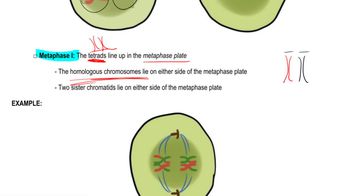In eukaryotic DNA, where are you most likely to find histone protein H4?
Table of contents
- 1. Introduction to Genetics51m
- 2. Mendel's Laws of Inheritance3h 37m
- 3. Extensions to Mendelian Inheritance2h 41m
- 4. Genetic Mapping and Linkage2h 28m
- 5. Genetics of Bacteria and Viruses1h 21m
- 6. Chromosomal Variation1h 48m
- 7. DNA and Chromosome Structure56m
- 8. DNA Replication1h 10m
- 9. Mitosis and Meiosis1h 34m
- 10. Transcription1h 0m
- 11. Translation58m
- 12. Gene Regulation in Prokaryotes1h 19m
- 13. Gene Regulation in Eukaryotes44m
- 14. Genetic Control of Development44m
- 15. Genomes and Genomics1h 50m
- 16. Transposable Elements47m
- 17. Mutation, Repair, and Recombination1h 6m
- 18. Molecular Genetic Tools19m
- 19. Cancer Genetics29m
- 20. Quantitative Genetics1h 26m
- 21. Population Genetics50m
- 22. Evolutionary Genetics29m
7. DNA and Chromosome Structure
Eukaryotic Chromosome Structure
Problem 6
Textbook Question
During what genetic process are lampbrush chromosomes present in vertebrates?
 Verified step by step guidance
Verified step by step guidance1
Understand what lampbrush chromosomes are: they are large, extended chromosomes with many loops, visible under a microscope during a specific stage of cell division in certain vertebrate cells.
Recall that lampbrush chromosomes are characteristic of the diplotene stage of prophase I during meiosis, where homologous chromosomes are paired and crossing over occurs.
Identify that lampbrush chromosomes are found in oocytes (immature egg cells) of vertebrates, where they facilitate active transcription of genes during this prolonged meiotic stage.
Recognize that the genetic process during which lampbrush chromosomes are present is meiosis, specifically during prophase I when homologous recombination and chromosomal pairing happen.
Summarize that lampbrush chromosomes are a feature of meiotic prophase I in vertebrate oocytes, reflecting a high level of transcriptional activity during this stage.
 Verified video answer for a similar problem:
Verified video answer for a similar problem:This video solution was recommended by our tutors as helpful for the problem above
Video duration:
3mPlay a video:
Was this helpful?
Key Concepts
Here are the essential concepts you must grasp in order to answer the question correctly.
Lampbrush Chromosomes
Lampbrush chromosomes are large, extended chromosomes found in the oocytes of vertebrates during a specific stage of meiosis. They have distinctive lateral loops that represent active transcription sites, making them visible under a microscope. These chromosomes facilitate high levels of gene expression needed for oocyte development.
Recommended video:
Guided course

Chromosome Structure
Meiosis and Its Stages
Meiosis is a specialized cell division process that reduces the chromosome number by half to produce gametes. It consists of two divisions: meiosis I and II. Lampbrush chromosomes appear during the prolonged diplotene stage of prophase I, where homologous chromosomes are paired but transcriptionally active.
Recommended video:
Guided course

Meiosis Steps
Oogenesis in Vertebrates
Oogenesis is the process of egg cell formation in female vertebrates. During oocyte development, meiosis is arrested at the diplotene stage of prophase I, where lampbrush chromosomes are present. This arrest allows extensive transcription to support early embryonic development after fertilization.
Recommended video:
Guided course

Gamete Development
Related Videos
Related Practice
Textbook Question
470
views


